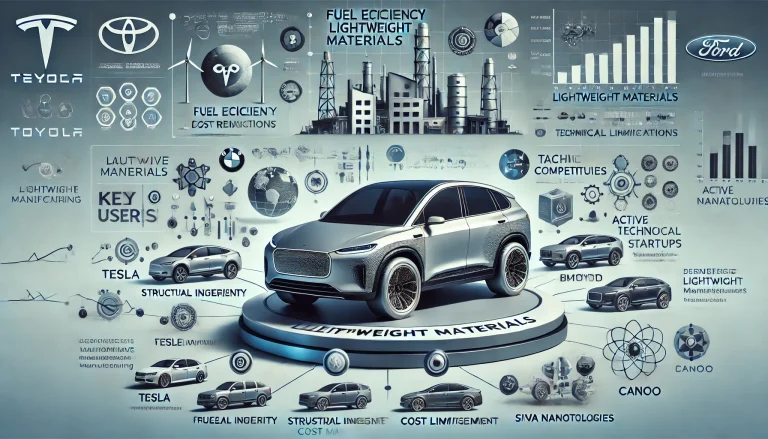Problem Statement
The development and adoption of lightweight materials in vehicle manufacturing are crucial for improving fuel efficiency and reducing emissions. However, challenges include ensuring the structural integrity and safety of these materials, managing costs, and overcoming technical limitations. Advancing lightweight material technology is essential for the future of sustainable automotive design.
Pain Points
- Structural Integrity: Ensuring lightweight materials maintain safety standards.
- Cost Management: High costs of advanced materials and manufacturing processes.
- Technical Limitations: Difficulties in mass production and material joining.
- Recycling Issues: Challenges in recycling advanced composite materials.
- Market Acceptance: Resistance from manufacturers due to unfamiliarity and cost.
- Supply Chain: Limited availability and higher prices of raw materials.
- Regulatory Compliance: Meeting stringent safety and environmental regulations.
- Performance Consistency: Variability in material performance under different conditions.
- Integration: Compatibility with existing manufacturing infrastructure.
- Research and Development: High investment required for ongoing innovation.

Future Vision
The future of automotive manufacturing hinges on the successful integration of lightweight materials to achieve significant improvements in fuel efficiency and emission reductions. By advancing technology, reducing costs, and overcoming technical limitations, the industry can transition to more sustainable practices. Innovations in material science and manufacturing processes will pave the way for safer, more efficient vehicles. Collaboration among stakeholders, including material suppliers, manufacturers, and regulatory bodies, will be essential to drive this transformation. The ultimate goal is a sustainable automotive industry that contributes to environmental preservation without compromising safety or performance.
Use Cases
- Passenger Vehicles: Improved fuel efficiency and lower emissions.
- Commercial Trucks: Enhanced payload capacity and fuel economy.
- Electric Vehicles: Increased range through reduced weight.
- Public Transport: Lightweight buses for better fuel efficiency.
- Aerospace Applications: Cross-industry benefits in aviation.
- Sports Cars: High-performance vehicles with superior speed and handling.
- Heavy Machinery: Efficient construction and agricultural equipment.
- Marine Vessels: Lightweight ships for fuel savings.
- Railway Systems: Efficient and faster trains.
- Bicycles and Motorcycles: Improved performance and efficiency.
Target Users and Stakeholders
- User: Automotive Manufacturers
- Age Group: 30-60 years
- Gender: M/F
- Usage Pattern: Daily use in design and production processes.
- Benefit: Improved vehicle efficiency and compliance with regulations.
- Stakeholders:
- Automotive engineers and designers
- Material suppliers
- Regulatory bodies
- Consumers
- Environmental organizations
Key Competition
- Tesla: Pioneering the use of lightweight materials in electric vehicles.
- Toyota: Advancing hybrid and lightweight material technologies.
- BMW: Innovative use of carbon fiber in automotive design.
- Ford: Extensive research in lightweight aluminum for trucks.
- Audi: Development of lightweight construction techniques.
Products/Services
- Tesla: Lightweight aluminum and battery technology.
- Toyota: Hybrid vehicles with advanced material use.
- BMW: Carbon fiber reinforced plastics (CFRP) in iSeries.
- Ford: Aluminum bodies in F-Series trucks.
- Audi: Aluminum and hybrid construction in various models.
Active Startups
- Carbon Revolution: Lightweight carbon fiber wheels.
- Sila Nanotechnologies: Advanced battery materials.
- Canoo: Electric vehicles with modular designs.
- Lightweight Metals: Innovations in aluminum alloys.
- Hyperloop Technologies: Lightweight materials for high-speed transport.
- NIO: Electric vehicles with advanced materials.
- Lucid Motors: Luxury EVs with lightweight construction.
- Rivian: Adventure-oriented electric trucks and SUVs.
- Byton: Smart electric vehicles with lightweight designs.
- Arrival: Electric delivery vans using composite materials.
Ongoing Work in Related Areas
- Advanced Composites: Research on stronger, lighter composites.
- Recycling Techniques: Methods to recycle lightweight materials.
- Mass Production: Technologies for scalable production.
- Cost Reduction: Innovations to lower manufacturing costs.
- Safety Testing: Ensuring materials meet safety standards.
- Hybrid Materials: Combining different materials for optimal performance.
- Supply Chain Improvements: Enhancing availability of raw materials.
- Sustainability: Eco-friendly production processes.
- Performance Optimization: Improving material performance.
- Collaboration: Industry partnerships for shared research.
Recent Investment
- Tesla: $1.5 billion in advanced material R&D (2023)
- BMW: $750 million in carbon fiber technology (2022)
- Ford: $500 million in aluminum research (2022)
- Lucid Motors: $2 billion in lightweight EV manufacturing (2023)
- Arrival: $300 million in composite material development (2023)
Market Maturity
The market for lightweight materials in automotive manufacturing is maturing, with significant advancements in material science and growing acceptance among major manufacturers. However, challenges remain in cost reduction, mass production, and recycling, indicating a need for continued innovation and investment.
Summary
The automotive industry’s shift towards lightweight materials is driven by the need to improve fuel efficiency and reduce emissions. While these materials offer significant benefits, including enhanced performance and sustainability, they also pose challenges related to structural integrity, cost, and technical limitations. The future of automotive manufacturing depends on overcoming these obstacles through ongoing research, innovation, and collaboration among stakeholders. Key competitors and startups are actively working to advance lightweight material technology, and recent investments highlight the industry’s commitment to sustainable practices. As the market matures, the successful integration of lightweight materials will be crucial for the development of safer, more efficient, and environmentally friendly vehicles.



